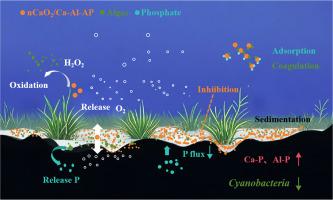凹棒石基钙铝ldh复合纳米cao 2同步除藻和固定化磷控制蓝藻华
IF 12.4
1区 环境科学与生态学
Q1 ENGINEERING, ENVIRONMENTAL
引用次数: 0
摘要
利用改性粘土将蓝藻从地表水转移到沉积物中是控制富营养化系统蓝藻华的一项既定应急措施。然而,沉积藻类生物量的积累和随后的腐烂促进了沉积磷的释放,损害了这种干预措施对抗富营养化和水华复发的长期效果。本研究采用原位加载法合成了凹凸棒土基钙铝层状双氢氧化物与纳米过氧化钙(nCaO₂/Ca-Al-LDH)。通过模拟实验研究了nCaO 2 /Ca-Al-LDH对蓝藻的去除和对沉积物磷释放的抑制作用。在受控的沉积物-水模拟系统中,该材料显示出双重功能,同时去除蓝藻和抑制沉积物磷的释放。值得注意的是,添加nCaO₂/Ca-Al-LDH (1.0 g/L)的体系在1天内对叶绿素a (Chl-a)的去除率为90.48%,且在整个培养过程中,Chl-a浓度一直保持在较低的水平(0.02 ~ 0.03 mg/L)。与对照体系相比,nCaO 2 /Ca-Al-LDH体系的沉积物总磷含量增加了42.75%,孔隙水正磷酸盐和总磷浓度分别降低了45.79%和39.59%。该复合材料还使沉积物活性磷(NH₄Cl-P)含量降低了16.91%,使难熔组分al -结合P和ca -结合P含量分别提高了2.72%和74.64%,这些变化使沉积物-水界面(SWI)磷通量降低了50.0%以上。nCaO₂/Ca-Al-LDH还能在7天内将上覆水体溶解氧含量提高到4.3-15.2 mg/L,防止藻类腐烂引起的缺氧,维持SWI的氧条件。观察到的沉积物中蓝藻属相对丰度的减少进一步证明了该物质在抑制蓝藻生长方面的长期功效。总之,所制备的复合材料在防止蓝藻华方面具有很大的应用潜力。本文章由计算机程序翻译,如有差异,请以英文原文为准。

Synchronous algal removal and phosphorus immobilization by attapulgite-based Ca-Al-LDH incorporated with nano-CaO₂ for cyanobacterial bloom control
Relocating cyanobacteria from surface waters to sediments using modified clay is an established emergency measure for controlling cyanobacterial bloom in eutrophic systems. However, the accumulation and subsequent decay of settled algal biomass promote sedimentary phosphorus release, compromising the long-term efficacy of this interventions measure against eutrophication and bloom recurrence. This study synthesized attapulgite-based calcium-aluminum layered double hydroxide incorporated with nano-calcium peroxide (nCaO₂/Ca-Al-LDH) via in-situ loading. The simultaneous cyanobacterial removal and inhibition of sediment phosphorus release by nCaO₂/Ca-Al-LDH were investigated through simulated experiments. In controlled sediment-water simulation systems, this material showed dual functionally, simultaneously removing cyanobacteria and suppressing sediment phosphorus release. Notably, the system with nCaO₂/Ca-Al-LDH (1.0 g/L) showed 90.48% chlorophyll-a (Chl-a) removal within 1 day, with the Chl-a concentration remaining consistently low (0.02–0.03 mg/L) throughout the cultivation period. Further, compared with the control system, the nCaO₂/Ca-Al-LDH system exhibited a 42.75% increase in sediment total phosphorus content accompanied by 45.79% and 39.59% decreases in pore water orthophosphate and total phosphorus concentrations, respectively. This composite material also decreased sediment labile phosphorus (NH₄Cl-P) content by 16.91%, while increasing the contents of refractory fractions, Al-bound P and Ca-bound P, by 2.72% and 74.64%, respectively, and collectively, these changes suppressed sediment-water interface (SWI) phosphorus flux by over 50.0%. nCaO₂/Ca-Al-LDH also increased the dissolved oxygen content of overlying water to 4.3–15.2 mg/L within 7 days, preventing algal decay-induced hypoxia and maintaining oxic conditions at the SWI. The observed reduction in the relative abundance of the genus Cyanobacteria in sediments further demonstrates the long-term efficacy of the material in suppressing cyanobacterial growth. Overall, the fabricated composite has great potential for application in preventing cyanobacterial blooms.
求助全文
通过发布文献求助,成功后即可免费获取论文全文。
去求助
来源期刊

Water Research
环境科学-工程:环境
CiteScore
20.80
自引率
9.40%
发文量
1307
审稿时长
38 days
期刊介绍:
Water Research, along with its open access companion journal Water Research X, serves as a platform for publishing original research papers covering various aspects of the science and technology related to the anthropogenic water cycle, water quality, and its management worldwide. The audience targeted by the journal comprises biologists, chemical engineers, chemists, civil engineers, environmental engineers, limnologists, and microbiologists. The scope of the journal include:
•Treatment processes for water and wastewaters (municipal, agricultural, industrial, and on-site treatment), including resource recovery and residuals management;
•Urban hydrology including sewer systems, stormwater management, and green infrastructure;
•Drinking water treatment and distribution;
•Potable and non-potable water reuse;
•Sanitation, public health, and risk assessment;
•Anaerobic digestion, solid and hazardous waste management, including source characterization and the effects and control of leachates and gaseous emissions;
•Contaminants (chemical, microbial, anthropogenic particles such as nanoparticles or microplastics) and related water quality sensing, monitoring, fate, and assessment;
•Anthropogenic impacts on inland, tidal, coastal and urban waters, focusing on surface and ground waters, and point and non-point sources of pollution;
•Environmental restoration, linked to surface water, groundwater and groundwater remediation;
•Analysis of the interfaces between sediments and water, and between water and atmosphere, focusing specifically on anthropogenic impacts;
•Mathematical modelling, systems analysis, machine learning, and beneficial use of big data related to the anthropogenic water cycle;
•Socio-economic, policy, and regulations studies.
 求助内容:
求助内容: 应助结果提醒方式:
应助结果提醒方式:


